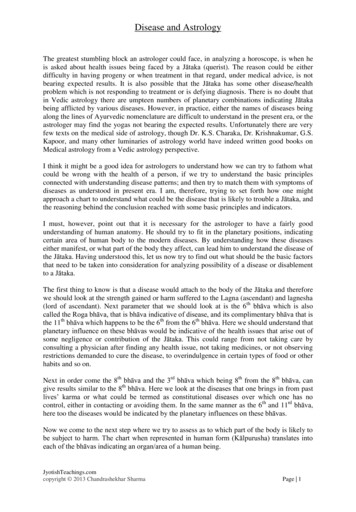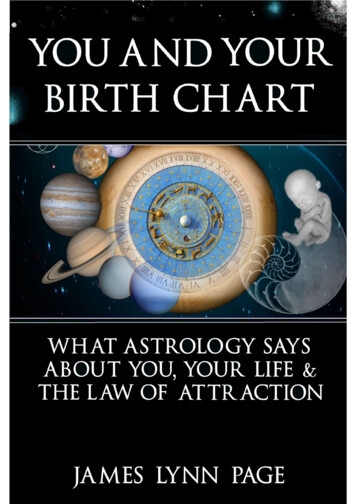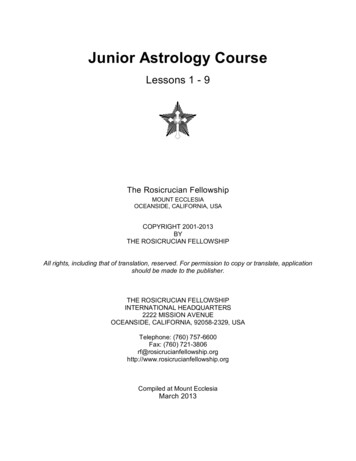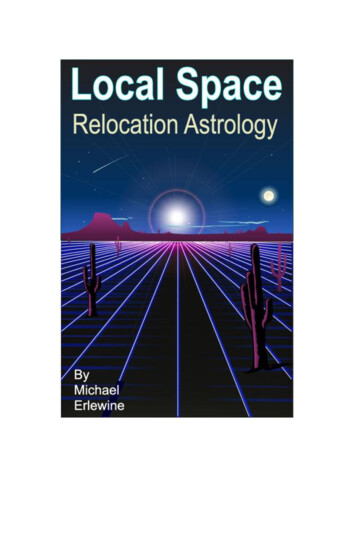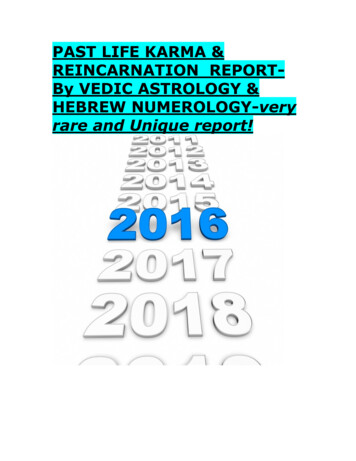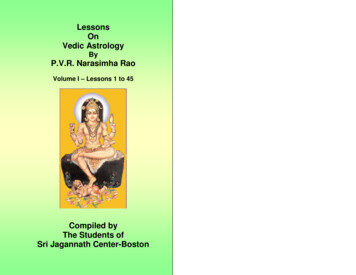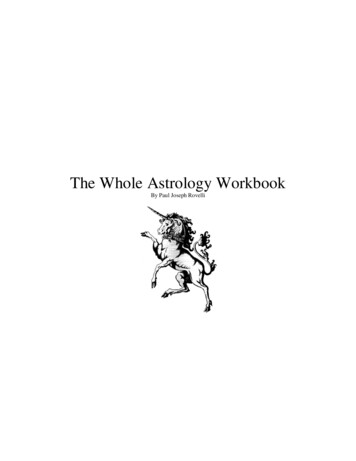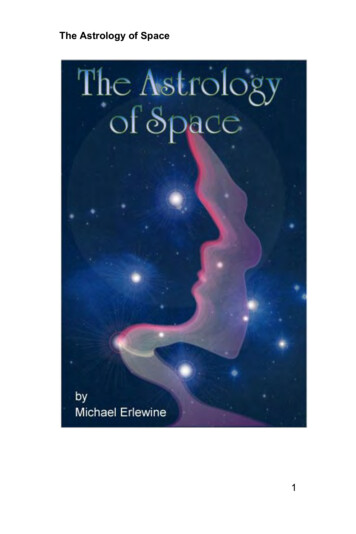
Transcription
The Astrology of Space1
The Astrology of SpaceThe AstrologyOfSpaceByMichael Erlewine2
The Astrology of SpaceAn ebook fromStartypes.com315 Marion AvenueBig Rapids, Michigan 49307Fist published 2006 2006 Michael Erlewine/StarTypes.comISBN 978-0-9794970-8-7All rights reserved. No part of the publication may bereproduced, stored in a retrieval system, ortransmitted, in any form or by any means, electronic,mechanical, photocopying, recording, or otherwise,without the prior permission of the publisher.Graphics designed by Michael ErlewineSome graphic elements 2007JupiterImages Corp.Some Photos Courtesy of NASA/JPL-Caltech3
The Astrology of SpaceThis book is dedicated toCharles A. JayneAnd also to:Dr. Theodor LandscheidtJohn D. Kraus4
The Astrology of SpaceTable of ContentsTable of Contents. 5Chapter 1: Introduction . 15Astrophysics for Astrologers . 17Astrophysics for Astrologers . 22Interpreting Deep Space Points . 25Part II: The Radio Sky . 34The Earth's Aura . 38The Kinds of Celestial Light . 39The Types of Light . 41Radio Frequencies . 43Higher Frequencies. 44Part III: Astrophysical Directions . 49The Sacred Zodiac. 55Chapter 2: The Solar System . 57Solar System . 57The Planets of Our Solar System. 59The Sun . 60The Sun Data . 61The Moon . 62Mother Moon . 63Mercury . 65Venus. 66Earth . 67Mars . 68Jupiter . 69Saturn . 70Uranus . 71Neptune . 72Pluto. 73Invariable Plane of the Solar System . 74Invariable Plane . 75The Asteroids . 765
The Astrology of SpaceThe Trojan Asteroids. 78Ceres . 80Pallas . 81Juno . 82Vesta. 83Chapter 3: Beyond the Solar System . 84The Solar Wind . 84Meteors . 87Meteors Table . 89Famous Meteorite Craters . 90Comets . 91The Head of the Comet. 92Spectacular Comets. 93Table of Comets. 95Chapter 4: Local Star System . 97The Nearest Stars . 97Near Stars Table . 98The Local System (Gould's Belt) . 99The Plane of the Local System . 102Via Combusta -- The Southern Stream . 104Chapter 5: The Milky Way Galaxy . 106Our Local Spiral Arm Region . 106Our Galaxy . 108The Galactic Sphere . 110The Galactic disk . 111The Location of Our Sun . 112Chapter Four: The Galaxy . 113Spiral Arms . 113Differential Rotation . 115How Differential Rotation Works . 116Interstellar Dust . 118Windows to the Galaxy . 119Dark Nebulae . 120Dark Clouds and Interstellar Dust . 1206
The Astrology of SpaceDark Nebulae . 121Solar Apex . 122Star Streaming . 124Type of Solar Motion Table . 125The Galactic Center (GC) . 126The Galactic Nucleus . 128Chapter 6: Star Lives . 131The Birthplace of Stars . 133A Star is Born . 134Protostars . 135Stellar Equilibrium . 136The Stellar Prime of Life . 137A Red Giant . 138A Supernova . 140The End of Life for Stars . 141A Neutron Star . 143The Black Hole. 144Hertzsprung-Russell Diagram . 146Using Stars with your Natal Chart . 148Hertzsprung-Russell Diagram II . 151The Time Table for Our Sun in Years . 151Chapter 7: The Kinds of Stars . 152Double Stars . 152Double Stars: Equal Doubles . 153Double Stars: Unequal Doubles . 154Double Stars: Multiple Stars . 155Double Stars: Triple Stars . 156Rapid Binary . 157One star in very tight orbit around a larger star. . 157Physical Doubles or Binaries . 158Visual Binaries . 159Spectroscopic Binary Stars . 160Spectroscopic Binaries . 160Binary System . 162Eclipsing Binaries. 1637
The Astrology of SpaceSpectroscopic Binary Stars . 163Eclipsing Binaries. 163Variable Stars . 165Pulsating Variables . 165Explosive Variables. 166Variable Star Naming . 166The Two Types of Intrinsic Variables: . 167Extrinsic Variables . 167Intrinsic Variables. 167Periodic Variables . 168The Cepheid Variables . 168The RR Lyrae Stars . 169W. Virginis and RV Tauri Stars . 169Long-Period Variables . 170Semi-Regular Variables . 171Irregular Variables. 172Flare Stars . 173Flare Star Table . 173Magnetic Stars . 174Magnetic Stars Table . 174Novae: Exploding Stars . 175Dwarf Novae, Novae, and Recurrent Novae . 176Dwarf Novae . 177Recurrent Novae . 177Novae . 177Table of Novae . 178Supernovae . 181Table of Supernovae. 184Supernovae Remnants . 188White Dwarf Stars . 190White Dwarfs . 191Wolf-Rayet Stars . 192Wolf Rayet Table . 193Chapter 8: The Constellations . 194Table of Constellations . 1958
The Astrology of SpaceThe Named Stars . 198The Fixed Stars. 205Chapter 9: Clustering. 206Star Clusters . 206Open or Galactic Star Clusters . 208Table of Open Clusters . 211The Globular Star Clusters . 213Table of Globular Clusters . 214The Stellar Associations . 216Moving Clusters . 218Moving Clusters . 220O-Associations . 221Table of O-Associations . 222T-Associations . 223Table of T-Associations . 224Chapter 10: Deep Space Objects . 225Nebulae . 225Emission Nebulae . 226Reflection Nebulae. 227Table of Bright Diffuse Nebulae . 228Dark Nebulae . 229Dark Clouds and Interstellar Dust . 229Dark Nebulae . 230Planetary Nebulae . 230Planetary Nebula . 231Chapter 11: The Non-Visual Sky . 232Radio Sky . 235Supernova Remnants . 237Radio Sources . 238Objects within our solar system. . 238Radio emission from within our galaxy . 239Extragalactic Radio Sources . 241Pulsars . 243Pulsars . 2449
The Astrology of SpaceSeyfert Galaxies. 245Table of Seyfert Galaxies . 246XRays, Black Holes . 247X-Ray Points . 249Infrared Points. 252Table of Infrared Points. 253Chapter 12: External Galaxies . 255The Magellanic Cloud . 255"Snickers" . 256Local Group of Galaxies . 258The Dwarf Systems in the Local Group . 263Motion of the Galaxy and the Local Group . 264Direction of Motion of the Galaxy . 265Clustering Among Galaxies . 267The Local Supergalaxy . 269The Virgo Clusters . 271Clusters of Galaxies . 272Galaxies . 273Galaxies Table . 274Chapter 13: The Messier Catalogue . 277The Messier Catalog . 277Cosmic Structure . 281Local System of Stars . 282Our Galaxy . 285Our SuperGalaxy . 288Intersections . 291Cosmic Centers . 293Chapter 14: Mapping the Birth Chart . 296Steps in Mapping the Chart . 297Maps of the Earth and Heavens . 301The Moment of Birth and the Natal Chart . 303The Equatorial Sphere . 305Plotting Your Birth Chart on a Star Map . 307The Earth‟s Tilt . 30910
The Astrology of SpaceThe Tropics of Cancer and Capricorn . 312Planet Longitude and Latitude . 315From the Sky to the Chart Form: Part 1 . 317From the Sky to the Chart Form: Part 2 . 318From the Sky to the Chart Form: Part 3 . 319Snapshots of Earth at a Birth . 320The Ecliptic Sphere . 321The Celestial/Equatorial Sphere . 322The Horizon Sphere . 324The Tropical Zodiac or Ecliptic . 326The Ecliptic Plane . 327The Ecliptic Sphere . 329Geographic and Celestial Latitude . 331Circles of Latitude . 333North and South Circles . 335Cities on the Same Meridian . 336Longitude and Latitude . 337Longitude Meridian . 338Meridian Alignment . 340Horizon Coordinates . 342The Horizon System . 345The Pole Star (North Star) . 347The Obliquity of the Ecliptic . 348The Band of the Zodiac. 350Ecliptic Coordinate System . 351Equatorial Coordinates . 354Horizon Coordinate System . 357Mapping the Birth Chart . 359The Summer Sky . 361Introduction Summary . 365Summary of Ideas . 365More: The Natal Horizon . 366More yet: Cosmic Systems . 366Last But Not Least . . 369The Pleiades: Most Photographed Object . 37011
The Astrology of SpacePleiades Map . 371Space Coordinate Systems . 372Discovering Coordinate Systems . 372A Central Starting Point . 373Connecting the Dots . 374Resolving the Equatorial Plane . 375The Circle of Best Fit . 376The Poles . 377Chapter 15: Centers and Circulation . 378Cycles, Circles, Centers, and Circulation . 378Local Attraction . 382So Inclined . 387Cosmic Systems and Centers . 390Chapter 16: Star Catalog . 391CG Clusters of Galaxies . 392CS Cosmic Structure . 392DI Diffuse Nebulae . 393DN Dark Nebulae . 395EB Eclipsing Binaries . 395FL Flare Stars . 396G Galaxies . 396GA Galactic Associations . 401GC Galactic Clusters . 401IF Infrared Points . 402LG Local Group. 404MC Moving Clusters. 405ME Meteors . 405MS Magnetic Stars. 406N Novae . 406NG Near Groups of Galaxies . 409NS Near Stars . 409OA O-Associations. 409OC Open Clusters. 412P Pulsars . 415PL Planetary Nebula . 41712
The Astrology of SpaceQ Quasars . 418R Radio Points . 420Radio Holes . 423Spectroscopic Binaries . 424SG Seyfert Galaxies . 424SM Solar Motion . 424SN Supernovae. 425Solar System Points. 426T T-Associations . 430VB Visual Binaries . 431WD White Dwarfs. 431WR Wolf Rayet . 432X X-Ray . 432Chapter 17: Catalog of Stellar Objects . 436Aries. 436Taurus . 440Gemini . 446Cancer . 451Leo . 455Virgo . 459Libra . 463Scorpio . 468Sagittarius . 472Capricorn . 478Aquarius . 484Pisces . 487Michael Erlewine . 492A Brief Bio of Michael Erlewine . 493Example Astro*Image Card . 494Personal Astrology Readings . 495The Heart Center House . 496Heart Center Library . 497The All-Music Guide / All-Movie Guide . 498Heart Center Meditation Room . 500Heart Center Symbol . 50113
The Astrology of SpaceMusic Career . 503Email: . 50514
The Astrology of SpaceChapter 1: IntroductionThe sky above us has not changed much in millionsof years, but how we see that sky and how much of itwe see has changed forever in our lifetimes. Arevolution in astronomy has taken place, asastronomers and physicists venture beyond the visualspectrum and began to see the actual shape and formof the universe. The pinpoint stars that we have beenstaring at for centuries are literally just the tip of theiceberg, like the eyes in the human body. The shapeof the body of the universe itself has now beenpartially revealed and it is beautiful indeed.Astrologers have always followed astronomicalresearch (such as the discovery of Uranus, Neptune,Pluto, etc.) with open ears and with a mind to interpretwhat this or that astronomical discovery might meanastrologically. We now have astrologicalinterpretations for the outer planets, the asteroids,15
The Astrology of Spaceand so on. But this has not been as true for thelandmark discoveries of deep space objects likepulsars, quasars, radio and X-Ray sources, blackholes and the like. What do they mean?Perhaps it is because so much was discovered in asuch a relatively short time that astrologers have justnot had time to catch up. Some 35 years have passedsince I did the research for some of the material inthis book, which was first published in 1976 under thetitle “Astrophysical Directions.” Nothing of similarscope astrologically has appeared since that time.Aside from the interest of a few astrologers in one ortwo of the deep-space concepts, there has beenalmost no mention of this material. No echo hasreturned.With that in mind, I feel it is important to once againmake these astronomical discoveries available toastrologers in an easy-to-use and illustrated format. Inaddition, all of the more important fixed stars anddeep space objects like black holes, quasars, etc. areincluded here along with their familiar zodiacpositions, rather than the equatorial coordinates usedby astronomers. That way, as you read about aparticular celestial object, you can look that point up inyour own natal chart.16
The Astrology of SpaceAstrophysics for AstrologersTo begin, I would like to share a few experiences andthoughts concerning the structure in space beyondour solar system and how it might be of valueastrologically for learning more about who you areand what on earth you might be here for.I first became interested in deep-space astrologythrough exploring heliocentric astrology, the astrologyof our entire solar system. Early on, I was amazed atdifference between my standard geocentric natalchart and some of the other astrological coordinatesystems such as the heliocentric and Local Spacecharts. IAt that time my interest in the space beyondand surrounding our solar system was minimal. I wasput off by the billions of stellar objects out there and,on a more basic level, by the ideas of coldness and17
The Astrology of Spaceblackness I had been programmed to associate withouter space. I sure didn‟t want to go out there.Distant space somehow represented the epitome of'otherness' and 'foreign' to me. I was embarrassed (interms of astrological usage) by all of the books I hadread on the fixed stars, with the possible exception ofL. E. Johndro's book, “The Stars.” How was I todetermine the significance of these billions of starsand use them in my practice, when I had enoughdifficulty just using the nine planets?And then the unexpected happened. I had a dream, avery special dream. It was not an ordinary dream, butone of those dreams that are more real than wakingconsciousness and that take months to understandand absorb. It was placed deep in my consciousness.In fact, it was a kind of vision.In my dream the astrologer L. E. Johndro appeared tome and his eyes were filled with light. There wererays or stalks of light coming out of his eyes. Thisstrange being said but one word, "LOOK!," and withhis arm, he turned and pointed up to the night sky. Ilooked up and out there.As I opened my eyes, the sky was filled with brilliantpoints of light. The stars and all of this starry materialwere clustered together to form the great glowing archof the Milky Way or galactic plane. It was wondrousbeyond description and in that instant my heart wentout from me and filled this bright hall of space. Neveragain have I had the feeling of being here on earth,warm and trembling before the cold and black ofspace. I became the space and light and reversed mypolarity or changed my attitude. I understood in thatinstant that I was a living representative of this mothergalaxy, its child. I was the being from outer space I18
The Astrology of Spacehad always wondered about. Furthermore, I hadalways been so!From that night forward, I began to venture beyondthe zodiac in an inquiry as to the nature and structureof this universe. Here, in brief form, is what I found:Most important is the fact that we are an integral partof the cosmos, not some lonely outpost. In fact, eachof us is a node or information aggregate and theuniverse is in intimate contact with itself only throughus – through our eyes. We are part of the cosmicinformation conduit, the eyes of the universe. Thecosmos sees through our eyes, itself.The manifold nature of distant cosmic eventshappening out there in space is represented throughour very self and lives down here on earth. It livesthrough us. There is not only a correlation betweenthese seeming remote cosmic events and our person,but an identity as well. Information coming from thegalactic center (and elsewhere), carried byelectromagnetic and gravitational radiation from everylast star and cosmic plane and event, passes throughus at all times. We are in some way a node orinformation complex embedded in the matrix or webof manifestation. We look at ourself!While all that may sound pretty heady, theoverpowering idea that occurred when I made someacquaintance with the universe and its structure isthat there is no difference between out there and inhere. We are already out there! We ARE in deepspace and have been there from eternity until now.Our world, our self and relationships, are a perfectreflection of what IS and what is happening out there.Not an analogy, but an identity. Black holes,supernovae, quasars, and the like are not just remote19
The Astrology of Spacecosmic events, but this identical story is represented,reflected, lived, and acted out each day in our lives,by those of us living here on Earth.It seems that information circulates through theuniverse and our Identity or sense of our self is thisvery process of circulation. What we call "Identity" orknowing our self is not only a personal experience,but a relationship, in fact, a circulation, and a processof communion or communication – identification! Notonly is there a connection between our life and that ofour galaxy and universe, but: WE ARE thatconnection.A study of the structure of the universe, at any level(large or small) is a study of our self, and theguidelines of cosmic structure help to illustrate thespecific structure of our self. In summary, the ideathat I am unfolding here is: astrology is not only asymbolic system of psychological discussion. Thesymbol is also, in fact, real. If we say it is an analogy,then the analogy is complete down to the limits of anyspecific example we might chose.We are all time and space travelers. There are nobetter words that I know of than these of Emerson:"All inquiry into antiquity is the desire todo away with this wild, savage, andpreposterous There or Then, andintroduce in its place, the Here and theNow. Belzoni (an archeologist) digs andmeasures in the mummy-pits andpyramids of Thebes until he can see theend of the difference between themonstrous work and himself. When hehas satisfied himself, in general and indetail, that it was made
I first became interested in deep-space astrology through exploring heliocentric astrology, the astrology of our entire solar system. Early on, I was amazed at difference between my standard geocentric natal chart and some of the other astrological coordinate
